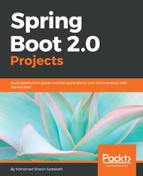Book Description
Develop diverse real-life projects including most aspects of Spring Boot
Key Features
- Run production-grade based applications using the Spring WebFlux framework
- Learn to develop high performance, asynchronous applications with Spring Boot
- Create robust microservice-based applications with Kotlin using Spring Boot
Book Description
Spring is one of the best tools available on the market for developing web, enterprise, and cloud-ready software. The goal of Spring Boot is to provide a set of tools for quickly building Spring applications that are easy to configure, and that make it easy to create and run production-grade Spring-based applications. Spring Boot 2.0 Projects will get you acquainted with important features of the latest version of this application-building tool and will cover basic, as well as advanced topics.
The book starts off by teaching you how to create a web application using Spring Boot, followed by creating a Spring Boot-based simple blog management system that uses Elasticsearch as the data store. As you make your way through the chapters, you'll build a RESTful web services application using Kotlin and the Spring WebFlux framework. Spring WebFlux is a new framework that helps in creating a reactive application in a functional way. Toward the end of the book, you will build a taxi-hailing API with reactive microservices using Spring Boot and a Twitter clone with a Spring Boot backend. Finally, you'll learn how to build an asynchronous email formatter.
What you will learn
- Learn the fundamental features of Spring Boot 2.0
- Customize Spring Boot 2.0 applications
- Build a basic web application
- Use Redis to build a taxi-hailing API
- Create a simple blog management system and a Twitter clone
- Develop a reactive RESTful web service with Kotlin using Spring Boot
Who this book is for
This book is for competent Spring developers who wish to understand how to develop complex yet scalable applications with Spring Boot. You must have a good knowledge of Java programming and be familiar with the basics of Spring.
Downloading the example code for this book You can download the example code files for all Packt books you have purchased from your account at http://www.PacktPub.com. If you purchased this book elsewhere, you can visit http://www.PacktPub.com/support and register to have the files e-mailed directly to you.
